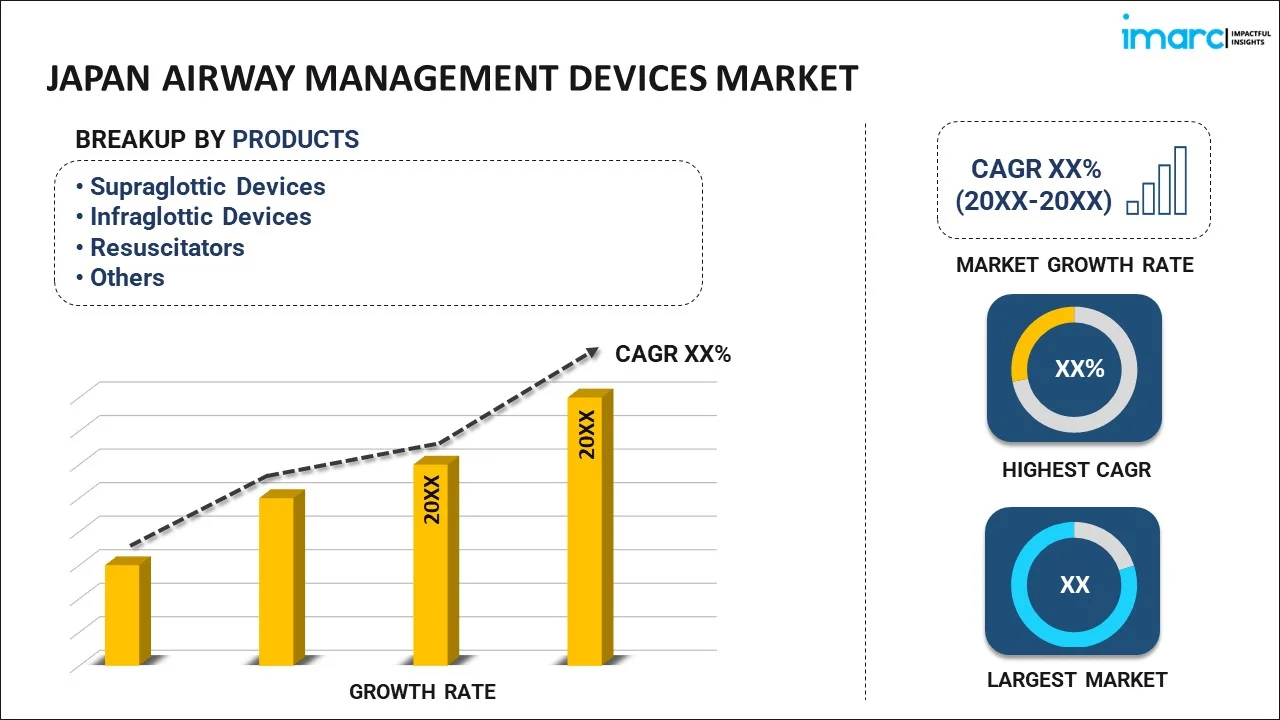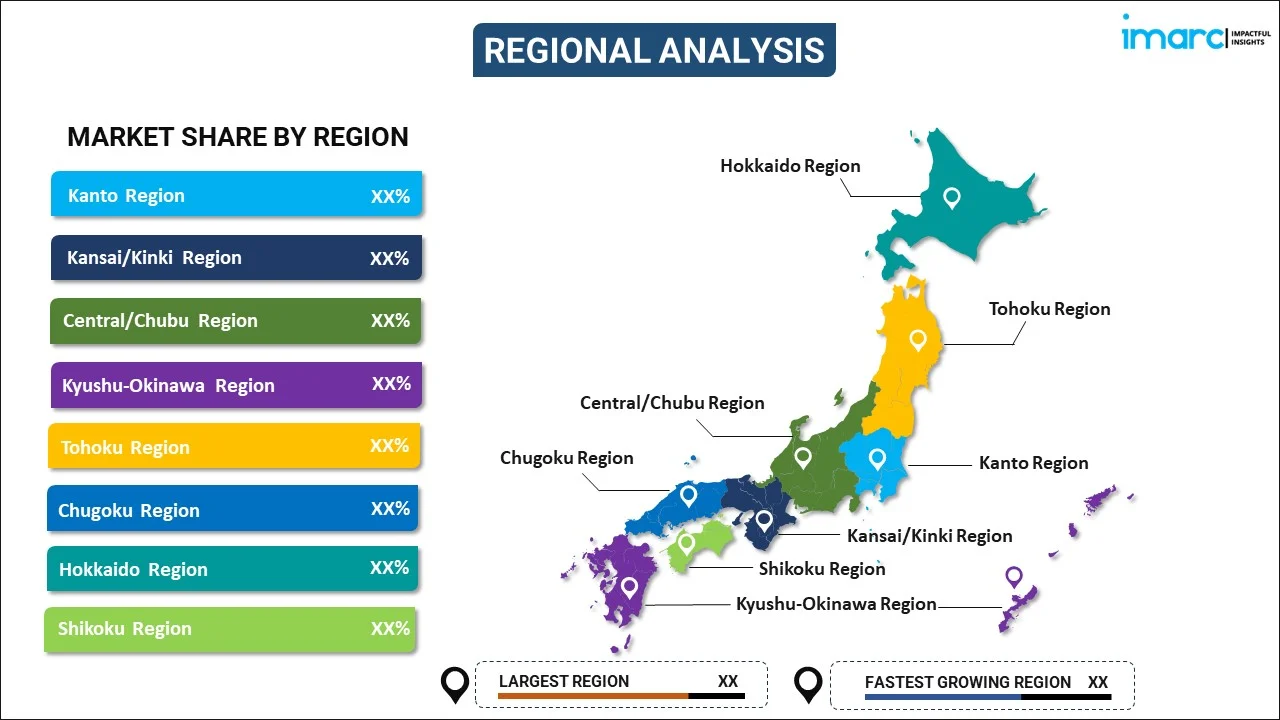
Japan Airway Management Devices Market Report by Product (Supraglottic Devices, Infraglottic Devices, Resuscitators, Laryngoscopes, and Others), Patient Type (Adult, Pediatric Patient/Neonates), Application (Anesthesia, Emergency Medicine, and Others), End Use (Hospitals, Homecare, and Others), and Region 2025-2033
Market Overview:
Japan airway management devices market size reached USD 136.0 Million in 2024. Looking forward, IMARC Group expects the market to reach USD 183.1 Million by 2033, exhibiting a growth rate (CAGR) of 3.40% during 2025-2033. The inflating need for maintaining proper ventilation and patient safety during operative procedures is primarily driving the market growth.
|
Report Attribute
|
Key Statistics
|
|---|---|
|
Base Year
|
2024 |
|
Forecast Years
|
2025-2033
|
|
Historical Years
|
2019-2024
|
| Market Size in 2024 | USD 136.0 Million |
| Market Forecast in 2033 | USD 183.1 Million |
| Market Growth Rate (2025-2033) | 3.40% |
Airway management devices serve the purpose of either preserving or reestablishing ventilation in patients. This entails a comprehensive process that encompasses assessment, strategy formulation, and the application of various medical techniques to address individuals experiencing respiratory issues or acute blockages. Additionally, these devices safeguard the lungs from harm and facilitate gas exchange for patients. Among the frequently employed airway management devices aimed at ensuring unobstructed ventilation through maintaining the openness of the upper airway are supraglottic airway devices (SADs), tracheal intubation, transtracheal access, and airway clearance methods.
Japan Airway Management Devices Market Trends:
The Japan airway management devices market is experiencing substantial growth, driven by a combination of factors that align with evolving healthcare needs. A primary driver is the increasing prevalence of respiratory diseases, which underscores the importance of effective airway management. Moreover, the rising number of surgical procedures, often involving anesthesia, contributes significantly to the demand for airway management devices. These devices play a critical role in ensuring proper ventilation, airway clearance, and patient safety during surgeries, bolstering their adoption. Furthermore, the market benefits from the growing need for emergency treatment for prolonged illnesses and extended care associated with lung diseases in both pediatric and adult patients, thereby acting as another significant growth-inducing factor. This trend fuels the demand for airway management devices that can provide efficient respiratory support. In addition, the introduction of advanced techniques for preoperative airway assessment, such as Preoperative Endoscopic Airway Evaluation (PEAE), is further enhancing market growth. This often involves the use of advanced devices like supraglottic airway devices, which offer easy tracheal placement and improved patient safety, making them valuable assets across various clinical applications. These factors will collectively contribute to the expanding adoption and growth of the Japan airway management devices market over the forecasted period.
Japan Airway Management Devices Market Segmentation:
IMARC Group provides an analysis of the key trends in each segment of the market, along with forecasts at the country level for 2025-2033. Our report has categorized the market based on product, patient type, application, and end use.
Product Insights:

- Supraglottic Devices
- Oropharyngeal Devices
- Naspharyngeal Devices
- Laryngeal Airway Devices
- Others
- Infraglottic Devices
- Endotracheal Tubes
- Tracheostomy Tubes
- Others
- Resuscitators
- Laryngoscopes
- Others
The report has provided a detailed breakup and analysis of the market based on the product. This includes supraglottic devices (oropharyngeal devices, naspharyngeal devices, laryngeal airway devices, and others), infraglottic devices (endotracheal tubes, tracheostomy tubes, and others), resuscitators, laryngoscopes, and others.
Patient Type Insights:
- Adult
- Pediatric Patient/Neonates
A detailed breakup and analysis of the market based on the patient type have also been provided in the report. This includes adult and pediatric patient/neonates.
Application Insights:
- Anesthesia
- Emergency Medicine
- Others
The report has provided a detailed breakup and analysis of the market based on the application. This includes anesthesia, emergency medicine, and others.
End Use Insights:
- Hospitals
- Homecare
- Others
A detailed breakup and analysis of the market based on the end use have also been provided in the report. This includes hospitals, homecare, and others.
Regional Insights:

- Kanto Region
- Kansai/Kinki Region
- Central/ Chubu Region
- Kyushu-Okinawa Region
- Tohoku Region
- Chugoku Region
- Hokkaido Region
- Shikoku Region
The report has also provided a comprehensive analysis of all the major regional markets, which include Kanto Region, Kansai/Kinki Region, Central/ Chubu Region, Kyushu-Okinawa Region, Tohoku Region, Chugoku Region, Hokkaido Region, and Shikoku Region.
Competitive Landscape:
The market research report has also provided a comprehensive analysis of the competitive landscape. Competitive analysis such as market structure, key player positioning, top winning strategies, competitive dashboard, and company evaluation quadrant has been covered in the report. Also, detailed profiles of all major companies have been provided.
Japan Airway Management Devices Market Report Coverage:
| Report Features | Details |
|---|---|
| Base Year of the Analysis | 2024 |
| Historical Period | 2019-2024 |
| Forecast Period | 2025-2033 |
| Units | Million USD |
| Scope of the Report | Exploration of Historical Trends and Market Outlook, Industry Catalysts and Challenges, Segment-Wise Historical and Future Market Assessment:
|
| Products Covered |
|
| Patient Types Covered | Adult, Pediatric Patient/Neonates |
| Applications Covered | Anesthesia, Emergency Medicine, Others |
| End Uses Covered | Hospitals, Homecare, Others |
| Regions Covered | Kanto Region, Kansai/Kinki Region, Central/ Chubu Region, Kyushu-Okinawa Region, Tohoku Region, Chugoku Region, Hokkaido Region, Shikoku Region |
| Customization Scope | 10% Free Customization |
| Post-Sale Analyst Support | 10-12 Weeks |
| Delivery Format | PDF and Excel through Email (We can also provide the editable version of the report in PPT/Word format on special request) |
Key Questions Answered in This Report:
- How has the Japan airway management devices market performed so far and how will it perform in the coming years?
- What has been the impact of COVID-19 on the Japan airway management devices market?
- What is the breakup of the Japan airway management devices market on the basis of product?
- What is the breakup of the Japan airway management devices market on the basis of patient type?
- What is the breakup of the Japan airway management devices market on the basis of application?
- What is the breakup of the Japan airway management devices market on the basis of end use?
- What are the various stages in the value chain of the Japan airway management devices market?
- What are the key driving factors and challenges in the Japan airway management devices?
- What is the structure of the Japan airway management devices market and who are the key players?
- What is the degree of competition in the Japan airway management devices market?
Key Benefits for Stakeholders:
- IMARC’s industry report offers a comprehensive quantitative analysis of various market segments, historical and current market trends, market forecasts, and dynamics of the Japan airway management devices market from 2019-2033.
- The research report provides the latest information on the market drivers, challenges, and opportunities in the Japan airway management devices market.
- Porter's five forces analysis assist stakeholders in assessing the impact of new entrants, competitive rivalry, supplier power, buyer power, and the threat of substitution. It helps stakeholders to analyze the level of competition within the Japan airway management devices industry and its attractiveness.
- Competitive landscape allows stakeholders to understand their competitive environment and provides an insight into the current positions of key players in the market.
Need more help?
- Speak to our experienced analysts for insights on the current market scenarios.
- Include additional segments and countries to customize the report as per your requirement.
- Gain an unparalleled competitive advantage in your domain by understanding how to utilize the report and positively impacting your operations and revenue.
- For further assistance, please connect with our analysts.
 Inquire Before Buying
Inquire Before Buying
 Speak to an Analyst
Speak to an Analyst
 Request Brochure
Request Brochure
 Request Customization
Request Customization




.webp)




.webp)












